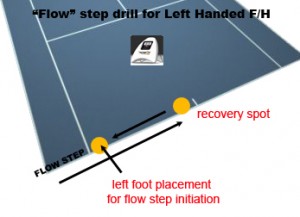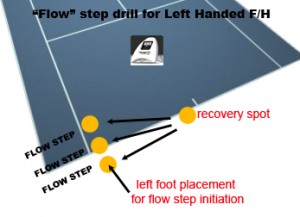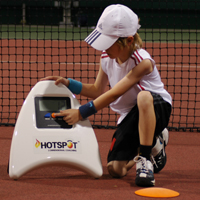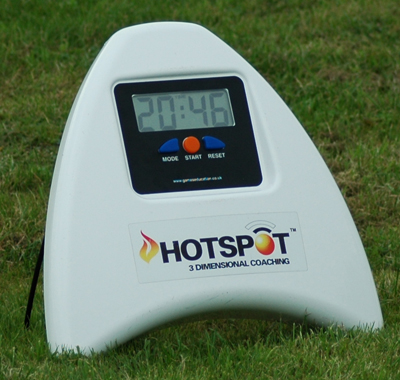- December 23rd, 2010
- Coaching/Training, Tennis Coaching
- admin
Welcome to the first “drill” post on the Hotspot blog. In this post I have created a drill to train/coach/test elements of the “flow” step used in variety of situations within tennis.
The “flow” step is commonly used as a means of defending wide balls that have caused you to be on the run and over stretched. The “flow” step allows you to hit the ball on the move and implement a braking method allowing quick and efficient recovery back into the court. I am going to provide 3 variations of the drill and alongside each provide some coaching tips and analysis.
Flow Step Drill 1:
In this drill there are simply two spots.
1. positioned as a recovery point.
2. positioned where the outside foot is placed in order to execute the flow step.
The drill is a repetitive exercise that puts the execution of the flow step and the recovery under pressure. There are two ways to do this. Firstly repeat for a period of time, say 20 seconds or secondly to perform a set number of repetitions, (using the hotspot will provide both methods and give times and scores as feedback). Obviously the repetitive nature is not tennis specific but the point of this is to isolate a “skill” and train it to be efficient and robust so it can be relied on in game play. Also during a drill of this nature players will stress their concentration and their technique whilst putting it under time and fatigue pressure.
For the drill the player is asked to move from the centre of the court, perform the flow step and recover back to the recovery spot and repeat. The timing of this will be affected by a number of variables. Clearly the ability to execute an efficient flow step will aid in allowing the player to go quickly, apply the brakes and recover.
Flow Step Drill 2:
This drill uses the same configuration as above. This time however, the system is put into it’s “zero” start mode which means that the first hit of a spot starts the timing. We are also going to use a count of 1 which means that the player will perform a single flow step (which will start the timer) and then recover as quickly as possible to the recovery spot (which will stop the timer).
This drill is aimed at measuring the effectiveness of the flow step and the recovery speed. Clearly improved times will reflect flow step braking and recover speed.
Flow Step Drill 3:
Flow steps can be executed in a variety of court positions. We can position spots in alternative areas as to apply more movement pressure and execution stress to the player.
I have set up the drill as in the picture below.
There are numerous options in which order things are done, for example top, middle, bottom repeat or bottom, middle, top, middle, bottom etc. Once again repetitions can be set or the drill can be done for time. The key point to this drill is that players must adapt to different movement patterns needed to move and recover to each of the 3 areas. This adds additional pressures to the drill and improves complexity. If players can perform the necessary skills in this environment there is a good chance they will be executed in game play.
These drills are not only useful for the “flow” step but by moving up the court and replacing with the appropriate footwork pattern you create a tactically, technically, physically, and mentally competent practice.
Finally, the hotspot system provides for precision and repeatability of the drills and most importantly provides accurate feedback on the players performance that coupled with subjective, observations from the coach can be extremely powerful. Players will gain a more complete understanding of where they are at and the level at which they perform. In addition there is no better motivation once players start to own their development.
Hope you enjoy this post and can make use of it!
MAKE IT COUNT!
www.gameseducation.co.uk
Continue reading






Leave a comment